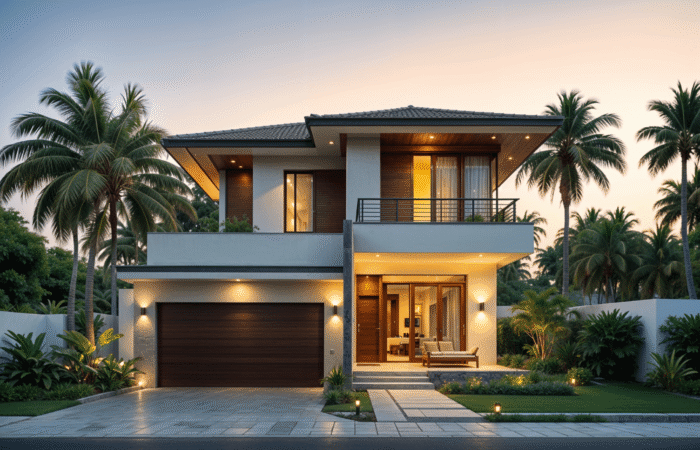Interior design in Kerala comes with unique challenges and opportunities due to the state’s distinctive climate, culture, and aesthetics. Whether you’re moving into a new home or planning to renovate, creating interiors that are both stylish and suited to Kerala’s environment can elevate your living space to a new level. This guide will cover essential factors to consider for a successful interior design project in Kerala.
Integrating Kerala’s Heritage: Local Style Tips
Kerala’s architecture and handicrafts are a treasure trove for home interiors. Here’s how a house interior designer in Kerala can weave them into a modern home:
- Laterite & Natural Stone: Use laterite cladding on a feature wall or as skirting around your living room. Its warm, earthy tone pairs beautifully with polished concrete or teak flooring.
- Traditional Jali & Woodwork: Incorporate carved wooden jali panels as room dividers or headboards. These not only lend privacy but also cast beautiful light-and-shadow patterns when backlit.
- Kolam & Mural Accents: Add a hand-painted mural or floor kolam motif in your foyer or puja nook. Choose durable, water-resistant paints to stand up to Kerala’s humid monsoon climate.
- Brass & Copper Touches: Accent your cabinetry handles, lighting fixtures, or planter pots with antique brass or copper—metals that patinate gracefully in coastal settings.
Understanding Kerala’s Climate and Its Impact on Interiors
Kerala’s tropical climate, characterized by high humidity and seasonal rains, significantly impacts interior design choices. High moisture levels can damage certain materials over time, leading to mold, warping, or corrosion. Here’s what to keep in mind:
-
- Humidity-resistant materials: Opt for moisture-resistant materials such as marine-grade plywood, treated wood, or metal for furniture and cabinetry. These materials are more resilient in high humidity, ensuring durability and low maintenance.
-
- Ventilation and airflow: Adequate cross-ventilation is essential to keep the interiors fresh and prevent moisture buildup. Large windows, louvered doors, and ventilated spaces promote airflow, reducing the risk of dampness.

Selecting Sustainable and Local Materials
Using locally sourced materials not only supports the local economy but also ensures compatibility with Kerala’s climate and aesthetics. Kerala offers an abundance of high-quality materials and craftsmanship, so make the most of it!
-
- Local craftsmanship: Kerala’s traditional furniture styles, often crafted from durable woods like rosewood and teak, add cultural charm and long-lasting quality to interiors. For a distinct aesthetic, try adding wooden carvings or intricately designed furniture pieces.
-
- Eco-friendly choices: Consider using sustainable materials like bamboo, cane, and coir, which are not only environmentally friendly but also resilient in the tropical climate.

Natural Lighting: Making the Most of Kerala’s Sunlight
Kerala’s abundant natural light is a boon for interior design, but it requires careful management to avoid excessive heat.
-
- Maximizing daylight: Use large windows, glass doors, and even skylights to allow natural light to flow through your space. Light-colored walls and reflective surfaces also help brighten interiors without artificial lighting.
-
- Sun protection: To manage sunlight effectively, install UV-protective films on windows, along with light-filtering curtains or blinds, which can prevent excessive heat during peak hours.

Designing with Kerala’s Cultural Aesthetics in Mind
Incorporating Kerala’s rich architectural heritage into modern interiors creates a blend of tradition and contemporary style.
-
- Traditional Kerala architecture: Features like wooden pillars, mural artwork, and clay-tiled roofs reflect the essence of Kerala’s design heritage. These elements not only add a unique visual appeal but also contribute to a culturally rich ambiance.
-
- Modern fusion: Combine traditional aesthetics with modern minimalism for a balanced look that’s practical yet timeless. Pair traditional artifacts with sleek furniture, or use earthy tones alongside contemporary layouts for a beautiful fusion.

Choosing Colors and Textures for Kerala Homes
The choice of colors and textures can make a home feel connected to Kerala’s natural beauty, providing both warmth and style.
-
- Color themes: Use warm tones like ochre, terracotta, and shades of green and blue to bring an earthy feel to interiors. These colors not only complement Kerala’s lush environment but also create a calm, soothing atmosphere.
-
- Natural textures: Incorporate textures like stone, exposed brick, and traditional tiles. These elements add depth to the decor and make the interiors look more rooted in Kerala’s natural surroundings.
Furniture and Space Optimization Tips
Space is precious, and making the most of it is key to creating a functional and comfortable home.
-
- Compact, multipurpose furniture: For smaller spaces, opt for furniture that’s compact and serves multiple purposes. Consider items like foldable tables, storage benches, or wall-mounted desks.
-
- Open layouts: Open floor plans promote better air circulation and create a spacious feel, which is ideal for Kerala’s humid climate. Avoid heavy partitions and choose light furnishings that maximize space and movement.
Weather-Proofing: A Must for Kerala Homes
Weather-proofing is essential to protect interiors from Kerala’s intense monsoon season, which can cause water seepage, mold, and damage.
-
- Waterproofing: Invest in proper waterproofing for walls, floors, and ceilings, particularly in areas exposed to rain. This will help prevent leaks and keep your interiors in top condition during the rainy season.
-
- Termite and mold protection: Due to the humid climate, ensure that wood furniture is treated against termites and mold. Using anti-termite coatings and mold-resistant paints can significantly prolong the lifespan of wooden furniture and fixtures.
Final Touches: Décor and Accessories
The right décor can make your space come alive, bringing in elements of Kerala’s rich culture and natural beauty.
-
- Adding plants: Indoor plants not only improve air quality but also add a fresh, green aesthetic to your interiors. Choose low-maintenance varieties like areca palms, snake plants, or ferns, which thrive in humid environments.
- Local art and artifacts: Kerala’s local artistry offers beautiful options for interior decor, from traditional mural art to brass lamps and Kathakali masks. These pieces bring a touch of Kerala’s cultural heritage into modern interiors.
Tailored Budget Tiers: Find Your Perfect Plan
|
Tier |
Cost Estimate (2BHK) |
Key Features |
|
Budget-Friendly |
₹5–8 lakhs |
Pre-designed modular units, DIY paint options, basic lighting upgrades. |
|
Mid-Range |
₹8–15 lakhs |
Semi-custom carpentry, designer fixtures, local stone accents. |
|
Premium |
₹15 lakhs+ |
Fully bespoke millwork, high-end materials (teak, marble), smart-home integration. |
How to Choose the Right House Interior Designer in Kerala
Selecting the perfect partner for your home makeover can be daunting. Here’s how to find the best house interior designer in Kerala for your needs:
- Review a local portfolio: Look for completed projects in Kerala’s key cities (Kochi, Thrissur, Kottayam) and pay attention to climatic adaptations—do past clients rave about humidity-proof finishes?
- Verify credentials and process: Ensure they’re clear on scope (design concept, material procurement, execution and handover) and ask about certifications (e.g., Vastu familiarity, sustainable-materials training).
- Assess communication and collaboration: Do they offer mood-board presentations, 3D walkthroughs or site-visit reports? A responsive designer who listens to your lifestyle needs will deliver a home that truly reflects you.
- Understand budget transparency: Check whether they provide tiered packages (Budget-Friendly, Mid-Range, Premium) with clear line-item estimates. Beware of hidden charges—make sure all labor, material and contingency costs are documented.
- Seek client testimonials: Read genuine reviews or chat with past clients—did the designer hit milestones on time? Look for feedback on how well they handled Kerala-specific challenges like monsoon workarounds.
Why Kerala Home Interior Designers Matter
Kerala’s unique blend of tropical climate, traditional architecture and vibrant culture means that a one-size-fits-all interior approach often falls short. Home interior designers in Kerala bring:
- Climate-savvy solutions: From moisture-resistant finishes to UV-coated glass, they know which materials withstand our heavy monsoons and intense sunlight.
- Cultural context: Whether it’s integrating a laterite accent wall or placing a mural inspired by Kathakali motifs, a local designer ensures your space feels authentically Kerala.
- Space optimization: Many Kerala homes feature verandas, sloping roofs and compact footprints. Experienced designers leverage these features—adding built-in storage, cross-ventilation strategies and seamless indoor–outdoor transitions—to make your house both beautiful and highly functional.
- Cost and time efficiency: With established vendor relationships and knowledge of regional suppliers, your house interior project in Kerala stays on budget and schedule, avoiding costly material delays or design mis-steps.
Conclusion
Ready to transform your home into a perfect blend of style and functionality? Start your interior design journey today by incorporating these tips tailored for Kerala’s unique climate and culture. Whether you’re renovating or building from scratch, thoughtful design choices can elevate your living space. Explore innovative ideas, sustainable solutions, and timeless aesthetics to create a home that truly reflects your personality.
Designing an interior in Kerala requires thoughtful choices that take the climate, culture, and space into account. By selecting the right materials, optimizing for natural light and airflow, and incorporating Kerala’s rich heritage into modern spaces, you can create a home that’s both beautiful and built to last. For expert guidance tailored to Kerala’s unique needs, reach out to Faboolux for interior design solutions that blend style with sustainability.
FAQ: Kerala Home Interior Design
Teak and rosewood for carpentry; quartz and porcelain for countertops; UV-coated glass for windows.
Typically 6–8 weeks from design sign-off to final handover, subject to material availability.
Absolutely—think laterite accent walls, brass fixtures, and hand-woven coconut-fiber rugs paired with contemporary furniture.
Yes, we source certified sustainable wood, low-VOC paints, and energy-efficient lighting to minimize environmental impact.

